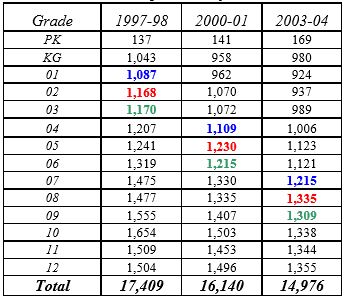Is Rural America Dying? Rewriting the Rural Narrative, Ben Winchester U of M
Part 4 of a Series By Marijo Vik www.normancountynewsonline.com
Nearly every rural county in Minnesota experienced a growth in the 35-44 year old cohort. This migration has occurred even in the southwestern portion of the state where, overall, total population has declined. However, we now see that even in the midst of total population decline, there is growth. The only counties that witnessed losses in this age cohort are Benton, Blue Earth, Hennepin, Koochiching, Ramsey, Watonwon and Winona.
Newcomers Bring Children
Could this all be some anomaly in the numbers? To better understand this phenomenon, we can analyze school enrollment data. If we have people aged 30-49 moving to rural counties, they may be bringing children. Do we see a corresponding increase in school enrollments?
In 2007, 19 school districts in west central Minnesota collaborated to complete an analysis of class cohorts using data obtained from the Minnesota Department of Education. School superintendents typically use class sizes of the previous year to estimate class sizes of the upcoming year. For example, if 100 children begin first grade this year, we expect 100 children to be in second grade next year.
Table 1: Class Size by Year in Collaborative Region, West Central Minnesota Source: Minnesota Department of Education

Conventional analysis of school enrollment data would look solely at totals. In this chart, we see a dramatic decline in the total enrollment, from 17,409 to 14,976 (Table 1). This is due primarily to lower fertility rates of the resident population. However, in the midst of this overall decline there is also growth.
The second grade class in 1997-1998 enrolled 1,168 students. Three years later, when this class was in fifth grade, their size grew to 1,230. Three years after that, when they were in eighth grade, it grew again to 1,335. This class gained 168 students (14 percent) during this time period. So, yes, there is growth here as well. So we see that the newcomer has a positive effect on school enrollments.
Where Do People Want to Live?
The Pew Research Center did a survey on where people want to live. The conclusions were that
23 percent of people surveyed want to live in the city, 25 percent in the suburbs, 30 percent in small towns and 21 percent in rural areas.
Reasons for Moving to Rural Communities
The University of Nebraska has done additional research to explore the qualities of these newcomers to the western panhandle of Nebraska. This area of the state has witnessed overall population loss, but does have growth of newcomers in the 30-44 year age cohort – similar to that in Minnesota.
A number moved from a metropolitan county. A large percentage of the newcomers are educated (40 percent have bachelor’s or higher) and had household incomes higher than the existing rural population (48 percent over $50,000).
Their findings were illuminating and similar to Minnesota. Newcomers indicated that they moved to rural towns because they wanted: 1) a simpler pace of life, 2) safety and security, and 3) low housing costs.
Recruitment versus Retention
Winchester said, “I want to differentiate on what we found between recruitment and retention because they are not the same. Recruitment involves people. It’s not the industrial recruitment model to get the 200 employee company in here. It’s about person by person, family by family working to get people to our small towns. And you know, in small towns little numbers mean big things. In the little town of Hancock (Minnesota) with 700 people, if you worked on bringing in seven people a year, that’s a 10 percent increase every year. That’s pretty healthy and I think a lot of people would like that.”
“Recruitment is regional and it involves people,” Winchester said. “When we started doing surveys of our newcomers in small towns, they didn’t look at just one small town. They looked at anywhere between three and five in a 30 to 45 mile radius.”
“Rural people live in the middle of everywhere,” Winchester said. “You live in one place, you work in another, you shop in another and you play in another and there is a radius of convenience around all of those. No small town is a ‘one stop shop’ any more. So this is a challenge, as we go forward, on how we market our small towns and how we describe what we’ve got. You can spend all the time you want describing all the things our small town doesn’t have, but you put your region together and there’s a lot to offer.”
Winchester said, “You know, I don’t want to eat in the same restaurant in my small town every week. I want to drive to Benson or Wilmer. I want to try something different. Rural people really don’t mind driving. So that is the recruitment side. Its people and regional based.”
“The retention side involves places,” Winchester said. “It’s about involving these newcomers socially and economically. They made the moved based on quality of life issues, then found a job. One surprising finding we made is that these newcomers weren’t always using their job skills or the experience they had in their previous life. So there’s an opportunity here because these people have secondary skills that can be tapped into.”
The Rural Negative Narrative
“I think traditional marketers struggle with recruitment,” Winchester said, “because there is no general profile aside from age, which is 30 to 49.”
Winchester then gave an example of negative feedback from a customer: “Awful customer service with zero regard for new loyal clients.”
“If this was your product or service, would you allow it to be talked about the way small towns get talked about?” Winchester asked. “You never would. The kind of negativity that permeates the future of our small towns based on the history we have in our small towns, you wouldn’t let that happen to your business or product. We need to counter this narrative.”
“We cannot continue to portray the rural successes as exceptions,” Winchester said. “It’s up to all of us to make sure the rural narrative gets enhanced by the data that we know and the stories that are told. Don’t buy in to someone else’s narrative. This negativity can impact the intentions of graduates and others to return. I’m countering this all the time.”
“The future of our small towns isn’t based on our past,” Winchester said. “It’s based on who is here now and who is going to be here.”
The next part of the series will focus on how to attract newcomers to your small town.
